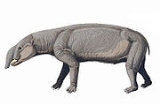
Astrapotherium magnum
Encyclopedia
Astrapotherium magnum is an extinct South America
n mammal
which vaguely resembled a cross between a small elephant
, and a very large tapir
. It may have fed on marsh plants. This peculiar-looking animal was unrelated to modern elephants, and was, instead, related to other extinct South American ungulates.
Astrapotherium had an elongated body, with a total length of about 2.5 metres (8.2 ft) and relatively short limbs. It had small, plantigrade
, feet, and the hind limbs were significantly weaker than the fore limbs. Its four canine teeth were elongated to form short tusks, and it had broad protruding lower incisors, which likely ground against a horny pad in the upper jaw, as in many modern ruminant
s.
The nostrils were placed high on the head, which might indicate the presence of a trunk, but could equally be due to other reasons, such as an inflatable nasal cavity. The animal was probably at least partially aquatic, living in shallow water and feeding on plants in a similar manner to a modern hippopotamus
.
South America
South America is a continent situated in the Western Hemisphere, mostly in the Southern Hemisphere, with a relatively small portion in the Northern Hemisphere. The continent is also considered a subcontinent of the Americas. It is bordered on the west by the Pacific Ocean and on the north and east...
n mammal
Mammal
Mammals are members of a class of air-breathing vertebrate animals characterised by the possession of endothermy, hair, three middle ear bones, and mammary glands functional in mothers with young...
which vaguely resembled a cross between a small elephant
Elephant
Elephants are large land mammals in two extant genera of the family Elephantidae: Elephas and Loxodonta, with the third genus Mammuthus extinct...
, and a very large tapir
Tapir
A Tapir is a large browsing mammal, similar in shape to a pig, with a short, prehensile snout. Tapirs inhabit jungle and forest regions of South America, Central America, and Southeast Asia. There are four species of Tapirs: the Brazilian Tapir, the Malayan Tapir, Baird's Tapir and the Mountain...
. It may have fed on marsh plants. This peculiar-looking animal was unrelated to modern elephants, and was, instead, related to other extinct South American ungulates.
Astrapotherium had an elongated body, with a total length of about 2.5 metres (8.2 ft) and relatively short limbs. It had small, plantigrade
Plantigrade
right|151px|thumb|Human skeleton, showing plantigrade habitIn terrestrial animals, plantigrade locomotion means walking with the podials and metatarsals flat on the ground. It is one of three forms of locomotion adopted by mammals...
, feet, and the hind limbs were significantly weaker than the fore limbs. Its four canine teeth were elongated to form short tusks, and it had broad protruding lower incisors, which likely ground against a horny pad in the upper jaw, as in many modern ruminant
Ruminant
A ruminant is a mammal of the order Artiodactyla that digests plant-based food by initially softening it within the animal's first compartment of the stomach, principally through bacterial actions, then regurgitating the semi-digested mass, now known as cud, and chewing it again...
s.
The nostrils were placed high on the head, which might indicate the presence of a trunk, but could equally be due to other reasons, such as an inflatable nasal cavity. The animal was probably at least partially aquatic, living in shallow water and feeding on plants in a similar manner to a modern hippopotamus
Hippopotamus
The hippopotamus , or hippo, from the ancient Greek for "river horse" , is a large, mostly herbivorous mammal in sub-Saharan Africa, and one of only two extant species in the family Hippopotamidae After the elephant and rhinoceros, the hippopotamus is the third largest land mammal and the heaviest...
.

